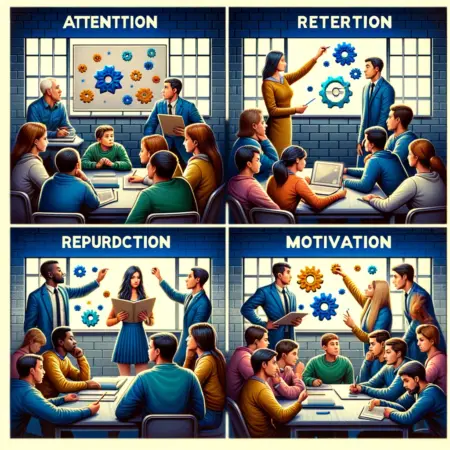Observational Learning is takes place without any direct reward or punishment.It is simply a result of observing the behavior of other people.This important process is learning by observation. Good teachers take advantage of their students’ ability to learn by observation.Learning by observation involves a sequence of four steps that Albert Bandura (1986) calls attention, retention, reproduction, and motivation.
Four Stages of Observational Learning.

Attention:
To learn from the behavior of other people, we must first pay attention to them and notice how they do things. Once of the reasons that television commercials use attractive actors is that we are likely to pay attention to them.
Retention:
After observing the model the person we learn from.We must store in memory a picture of the model carrying out that behavior. Remembering the model’s behavior is especially important because most behaviors learned through modeling aren’t put to use until some time later.
Reproduction:
Now we must take the mental image and convert it to actual behavior. In some cases, involving more complex responses, this step can be difficult. When one of the authors (Peter) was learning to play golf, he paid careful attention to pro golfer Tom Watson’s perfect swing and even retained the image in memory. Unfortunately, every time Peter tried to reproduce the image with his own behavior, the resulting swing didn’t look much like Tom Watson’s at all. Nonetheless, with practice people are able to produce—at least approximately many of the behaviors they observe.
Motivation:
People may acquire extensive information about all kinds of behaviors by observing other individuals. They will make use of this information, how- ever, only if they are motivated to produce the behavior themselves. Thus, Emilio, who has seen 143 cowboy movies, has a pretty fair idea of how to mount a horse. But he has absolutely no desire to try it himself.
In observational learning, two different things may be learned. One is a specific set of behaviors, such as a new dance step or the procedure for answering the phone in an office. Although such behaviors can also be taught by oral instruction or with a training manual, a good model is often worth a thousand words.
The second sort of thing that is learned by observation is whether a particular behavior is likely to be rewarded. A lawyer who is scheduled to try a case before a judge before whom the lawyer has never appeared is well advised to spend some time as a spectator in the back of the judge’s courtroom. If the lawyer discovers that the judge frequently sustains a particular sort of objection, the lawyer will be more likely to make such objections when the lawyer’s own case comes to trial. If, on the other hand, the lawyer learns that the judge reacts violently to such objections, the lawyer will avoid making them.
Thus, we learn by observation not only how to behave in a novel way but also what behaviors can be expected to lead to particular consequences. Many of our habits, values, skills, and beliefs are the products of observing others. For example, adolescents are more likely to start smoking if they have parents and friends who smoke. And children whose parents are heavy drinkers are more likely to become heavy drinkers themselves when they reach adulthood.
Observational learning, a concept developed by psychologist Albert Bandura, involves learning by observing and imitating the behavior of others. This process can be broken down into four key stages. Let’s outline these stages in a tabular format for a clear understanding:
| Stage | Description |
|---|---|
| 1. Attention | In this stage, the learner focuses on the model and pays attention to their behavior. This is crucial for learning to occur, as it involves noticing the details of the behavior being modeled. |
| 2. Retention | Here, the learner must remember what was observed. This involves encoding the observed behavior into memory, so it can be recalled later. It’s the process of storing the observed behaviors in the brain. |
| 3. Reproduction | In this stage, the learner attempts to replicate or imitate the behavior that has been observed. This involves converting the stored memory into actions. The accuracy of this replication can depend on the learner’s physical and intellectual capabilities. |
| 4. Motivation | This final stage determines whether the observed behavior is actually imitated. Motivation can be affected by factors such as the perceived rewards or punishments associated with the behavior, or the learner’s personal goals and values. |
This tabular guide encapsulates the sequential process of learning through observation, highlighting how each stage contributes to the overall learning experience.
In conclusion, understanding the stages of observational learning can help individuals harness this powerful learning method to acquire new knowledge, skills, and behaviors. By paying attention to models, imitating their behaviors, and applying them in relevant contexts, individuals can enhance their learning and foster personal development. Moreover, employing effective strategies and creating favorable learning conditions can optimize the outcomes of observational learning experiences. So, why not tap into the power of observational learning and unlock your potential?
